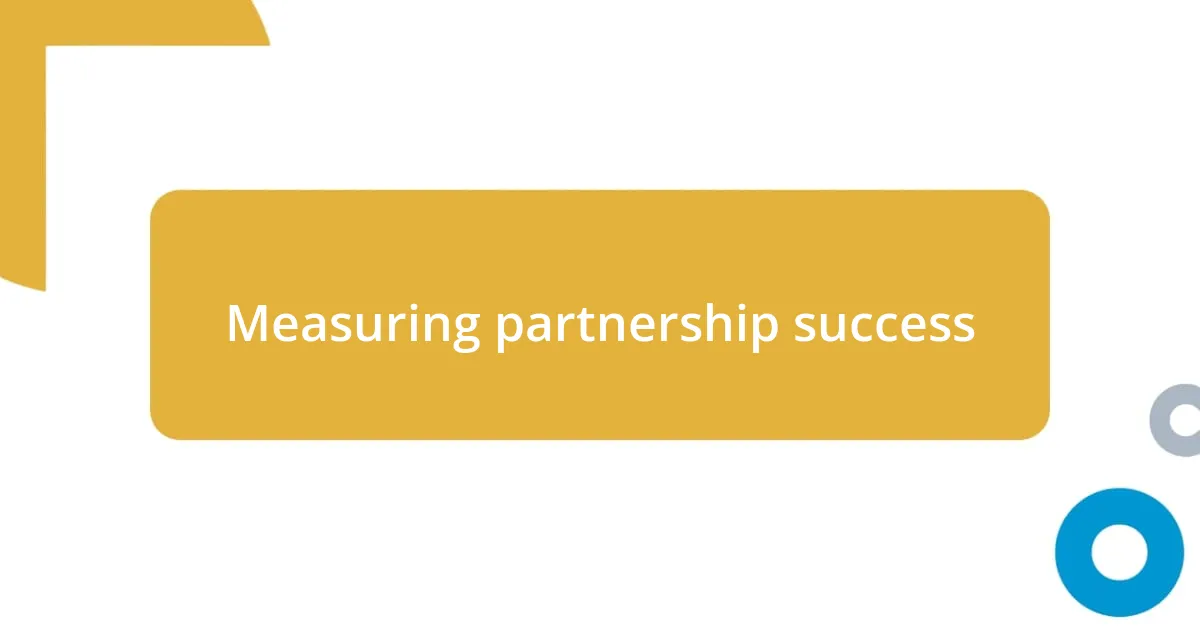Key takeaways:
- Brand partnerships hinge on aligning values and understanding target audiences to foster authenticity and trust.
- Successful collaborations can drive innovative marketing strategies, increase brand awareness, and create a sense of community.
- Establishing clear goals and maintaining open communication are essential for measuring partnership success and ensuring long-term relationships.

Understanding brand partnerships
Brand partnerships are more than just business agreements; they’re emotional connections between entities that share a common goal. I remember a time when two lifestyle brands collaborated on a limited edition product line. The excitement generated wasn’t just about the products; it was a synergy that captured the imaginations of their customer bases. How often do we see brands successfully combining their strengths to create something truly unique? It’s a reminder that collaboration can spark innovation.
When I think about effective brand partnerships, I consider how vital it is for both brands to align their values. I once witnessed a tech company and an eco-friendly brand join forces for a sustainable initiative, and the authenticity of their message resonated with consumers. Isn’t it fascinating how genuine alignment can elevate a campaign from merely profitable to purpose-driven? This alignment cultivates trust and loyalty, ultimately leading to long-term success.
Moreover, navigating the complexities of brand partnerships involves understanding the target audience of each brand. I’ve seen collaborations that missed the mark simply because they didn’t resonate with either group. How important, then, is it to research and understand your partner’s audience? The more you align your messaging and objectives, the more impactful your partnership can become, creating a win-win scenario for both parties.

Benefits of brand partnerships
When I reflect on the benefits of brand partnerships, one standout advantage is the shared audience access. I remember when a local bakery teamed up with a popular coffee shop. Each brand brought its loyal customers to the table, creating a delightful cross-promotional opportunity. It wasn’t just about selling cookies and lattes; it was about creating an enjoyable experience that both sets of customers loved.
Benefits of Brand Partnerships:
– Increased Brand Awareness: A partnership can exponentially increase visibility, leveraging each other’s marketing efforts.
– Cost-Effective Marketing: Sharing costs can lead to substantial savings on campaigns and events, allowing both brands to allocate budgets more efficiently.
– Innovation and Creativity: Two brands can combine their expertise, leading to unique products or campaigns that push creative boundaries.
– Enhanced Credibility: Associating with another reputable brand can elevate your own brand’s image and build consumer trust.
– Networking Opportunities: Collaborating often leads to new connections within the industry, opening doors for future endeavors.
Additionally, brand partnerships foster a sense of community. I recall a project where a fitness brand collaborated with a local charity. The campaign not only promoted wellness but also encouraged customers to participate in charitable events. This kind of partnership creates a deeper emotional connection with consumers, transforming transactions into meaningful interactions.

Identifying the right partners
When identifying the right partners, I believe that values alignment serves as the foundation of a successful collaboration. For instance, I once partnered with a small artisan brand that shared my passion for sustainability. This shared vision enabled us to craft a promotional event that felt authentic and resonated deeply with our audiences. It made me realize how essential it is to choose partners that not only complement your offerings but also share a heartfelt commitment to similar principles.
Another crucial aspect is assessing the compatibility of audiences. I remember collaborating with a local fitness center that attracted a demographic heavily focused on wellness. By aligning our marketing campaigns, we reached a broader audience while effectively communicating our messages. This experience underscored the need for thorough research into each partner’s customer base to create strategies that truly engage and excite potential customers.
Lastly, effective communication can make or break a partnership. During a previous project, I noticed how open dialogues with my partner helped us address challenges in real-time, preventing misunderstandings. This taught me that fostering a space for candid conversations ensures that both brands remain aligned and agile, adapting to the ever-changing marketplace as a cohesive unit.
| Criteria | Importance |
|---|---|
| Values Alignment | Essential for authenticity and trust |
| Audience Compatibility | Expands reach and engagement |
| Effective Communication | Fosters adaptability and synergy |

Setting clear partnership goals
Setting clear partnership goals is fundamentally about outlining what both parties hope to achieve. I recall one instance when I engaged in a partnership with an eco-friendly brand. We met early on to define our objectives: we wanted to boost awareness and spur engagement around a shared sustainability message. It was an enlightening conversation that not only guided our marketing focus but also solidified our commitment to a common purpose.
Having specific, measurable goals can truly make a difference. I once worked on a campaign where we aimed to increase our social media following by 20% within three months. Tracking our progress regularly helped us refine our strategies and adjust our efforts based on what was working. It made me realize how important it is to have clear targets in place; they act like a roadmap that keeps everyone focused and motivated throughout the partnership journey.
As you set goals, consider the emotional impact of your collaboration. I find that aligning ambitions with a story or mission resonates deeply with audiences. When the fitness and charity partnership I mentioned earlier aimed to raise funds for local health initiatives, it wasn’t just about the money; it was about making a difference. Have you ever thought about how your partnership goals relate to broader social challenges? That’s a powerful motivator that can infuse energy into your collaboration and amplify its success.

Strategies for effective collaboration
Effective collaboration is all about establishing a framework that supports both brands’ ambitions. I remember a time when I teamed up with a tech company to launch a new app. We took the time to outline our responsibilities and deadlines together, fostering a structure that kept everyone accountable. Have you ever felt the frustration that comes from vague expectations? That clarity we created not only helped us stay on track but also gave us a sense of shared ownership over the project.
Building trust is another vital strategy that plays a crucial role in collaboration. During one of my partnerships with a well-known influencer, we designated regular check-ins to share updates and address any concerns. It wasn’t just about meeting deadlines; it was about ensuring we were both heard and valued in the process. This experience showed me that cultivating trust requires consistency and transparency. Don’t you think that trust forms the bedrock of any relationship, especially in business?
Finally, I find that leveraging each partner’s strengths can lead to remarkable outcomes. In a campaign with a local artist, we integrated their creative vision into our marketing materials, which infused our brand story with fresh energy. It’s a reminder that acknowledging and using each other’s unique talents can elevate the collaboration. How often do we overlook the extraordinary potential that lies within our diverse team members? Embracing those differences can truly create a competitive edge.

Measuring partnership success
Measuring the success of a partnership is not just about crunching numbers; it’s about feeling the impact of those numbers on the relationship. I remember launching a joint campaign with a beverage brand, where we used a mix of engagement metrics, like shares and comments boosted by our partnership messaging. As we reviewed those stats, it was exciting to see how our audiences interacted with our content. Have you ever felt that thrill when you see the real-world effects of your collaboration? It’s a clear reminder that quantifiable results tell just part of the story.
Another crucial aspect I’ve found in measuring success involves aligning metrics with partnership goals. For instance, during a collaborative webinar series a few years back, we set out to generate leads and foster community engagement. Every registration and follow-up conversation counted, reinforcing that we were on the right path. The connection felt tangible when we realized we’d not only hit our target but also sparked meaningful dialogue within our audience. Isn’t it amazing how numbers can translate to connections?
Then there’s the emotional side of measurement that often goes overlooked. I’ve had moments where the success of a partnership didn’t fully capture in statistics. Working with a local non-profit, we inspired more volunteers than we initially anticipated. The joy and passion from the community members were hard to quantify but were undeniably there. It makes you wonder—how much value do we place on the stories and experiences that come from our partnerships? Sometimes the heart of a partnership shines brightest beyond the metrics.

Long term relationship management
Long-term relationship management is like nurturing a garden; it requires ongoing attention and care to flourish. I recall a particularly fruitful collaboration with a fashion brand where we established an annual review process. This wasn’t just about reflecting on what had worked, but also diving into how we could grow together. Have you ever experienced the feeling that comes from a partnership where both sides are genuinely invested in each other’s success? It’s exhilarating to witness a shared vision pave the way for sustained growth.
In my experience, the key to maintaining a long-lasting relationship often lies in open and honest communication. During a multi-year partnership with a nonprofit organization, we set aside time each quarter to evaluate our goals and redefine our strategies. This continuous dialogue allowed us to celebrate our achievements and recalibrate whenever challenges arose. It makes me think—how often do we overlook the power of simply talking things out to keep the relationship strong? I’ve found that when lines of communication are fluid, trust deepens, making it easier to navigate any bumps in the road together.
Equally important is recognizing and celebrating milestones, which keeps the relationship vibrant. Thinking back to a digital campaign I launched with a tech startup, we celebrated our first anniversary by releasing a joint video highlighting our journey. It wasn’t just about looking back; it reinforced our commitment to each other and reminded our audiences of the value of our partnership. Don’t you think acknowledging those moments not only strengthens bonds but also energizes teams for future endeavors? It’s these small celebrations that can breathe new life into ongoing collaborations, making the path forward much more enjoyable.












